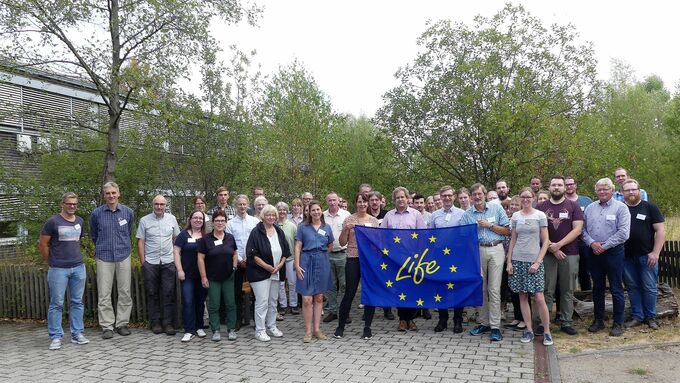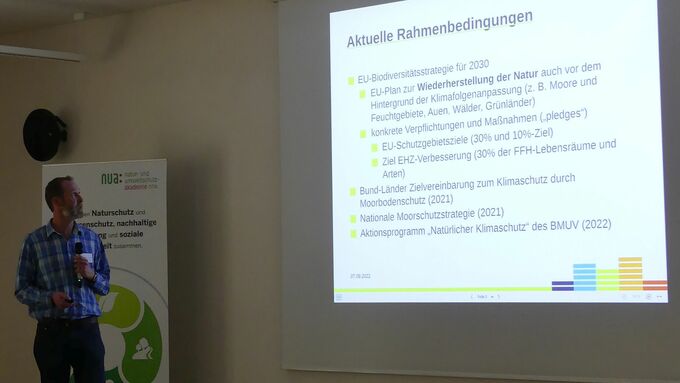Of course, a group photo with the LIFE flag was not to be missed at this event either. © Bezirksregierung Münster
download picturemain content
Project of the month
#9/2022 EXPERT CONFERENCE WITH WORKSHOP
Perspectives for peatland conservation in North Rhine-Westphalia
On 7th September 2022, the LIFE IP Atlantic Region DE in cooperation with ‘Natur- und Umweltschutzakademie NRW’ (North Rhine-Westphalian academy for nature and environment conservation, NUA) and the State Agency for Nature, Environment and Consumer Protection (LANUV) in North Rhine-Westphalia held a symposium once again. The event served as a direct exchange of experience for all interested actors and the identification of future fields of action for peatland conservation in North Rhine-Westphalia. About 50 participants came to Recklinghausen - most of them involved in the LIFE IP actions, but also employees of biological stations and lower nature conservation authorities as well as planning offices from other regions.
After a short welcoming speech by Ralf Schlüter, Head of the Department ‘Nature Conservation’ at the LANUV, the keynote lecture by Dr. Greta Gaudig from the Greifswald Mire Centre entitled ‘Status and conservation of peatlands in Germany’ followed as a live broadcast from Greifswald. In a very clear and impressive way, she gave a comprehensive overview of the consequences of drainage and increased land use pressure on peatlands: In addition to immense greenhouse gas emissions - about one third of emissions from agriculture and forestry worldwide result from drained soils - peat sagging of one to two centimetres per year is a major problem because it leads into a vicious circle with ever deeper drainage. In order to still be able to achieve the climate goals, a rapid increase in renaturation and rewetting measures is necessary, true to the much-quoted motto of the researchers from the Greifswald Mire Centre "Peatlands must be wet". Instead of the intensive agricultural use of drained peatland soils with a high ecological footprint, the withdrawal of animal husbandry, the creation of wilderness areas as well as a strengthening of paludiculture as a more sustainable form of use of peatland with peat preservation or even peat formation should be urgently promoted. Instead of the previous peatland conservation programmes with funding for individual projects, an overall area approach must be implemented as soon as possible. A first step is the new eligibility of paludiculture at EU level via the Common Agricultural Policy (CAP). But the necessary transformation of agriculture could also be promoted through additional remuneration of ecosystem services, for example through climate protection premiums or carbon certificates.
In the following presentation ‘Peatland conservation in North Rhine-Westphalia’, Dr. Tim Wertebach from the LANUV explained the current situation in the most populous federal state in Germany. He showed that despite considerable efforts of practical and official nature conservation, the situation of peatland habitat types is still predominantly assessed as unfavourable. Climate change in particular has made the conditions for applied peatland conservation more difficult, as significant water deficits during the vegetation period have increasingly occurred in recent years. Falling groundwater levels are making the situation for groundwater-fed peatlands and other habitats more critical. Nitrogen inputs, which are still far too high in many places in North Rhine-Westphalia, also complicate the management of nitrogen-sensitive peatland habitats. However, through the successful implementation of nature conservation measures, e.g. also in the framework of LIFE funding, further deterioration of peatlands could be prevented and in many cases even significant improvements could be achieved. Synergies between nature conservation and climate protection can best be realised where core nature conservation areas can be supported by large-scale rewetting measures. Often, a case-by-case assessment within the framework of hydrological studies is useful.
In the last lecture of the morning session, Prof. Dr. Klaus-Holger Knorr (Institute for Landscape Ecology at the WWU Münster) explained the questions of whether peatland conservation and climate protection can be equated and what effect peatland restoration measures have. Using numerous examples from current research work in different regions, he showed that a large-scale hydrological consideration is necessary for peatland restoration. Buffer zones in the catchment areas of peatlands must be taken into account, as well as the conditions in the aquifer, so that measures such as the installation of sheet pile walls or the construction of peat walls are successful. The overriding maxim is to keep precipitation water in the area for as long as possible so that summer deficits can be compensated. As shown by case studies, peatlands can then store carbon again in the long term. At the very least, however, there are significant savings in greenhouse gas emissions due to the higher water levels. Peat decomposition can thus be effectively reduced through rewetting. The bog-typical vegetation necessary for peat formation can be promoted by transferring suitable donor material.
Christian Finke from the Biological Station of the district Paderborn - Senne opened the two practical presentations after lunch break. In his 20-minute talk, he reported on the experiences from the LIFE+ project ‘Eggemoore’ which the Biological Station, the regional forestry office Hochstift and the Ministry for Climate Protection, Environment, Agriculture, Nature and Consumer Protection North Rhine-Westphalia jointly implemented from 2013 to 2019. Within the framework of the project, improvement measures were carried out in two areas of the NATURA 2000 network in the town of Lichtenau (district of Paderborn): in the SAC ‘Eselsbett und Schwarzes Bruch’ and in the SAC ‘Sauerbachtal Bülheim’. However, some difficulties arose in the process. For example, other types of structures had to be used than those originally planned. In addition, the implementation could not be carried out by the project partner, but had to be contracted out to a contractor. Finally, the intended land purchase was not possible, but adjacent land could be acquired instead. All this made it necessary to extend the project duration. In summary, it became clear that the LIFE-typical isolated consideration of habitat types and SACs proved to be insufficient in the implementation and that the entire catchment area of the areas to be irrigated must be taken into account in the planning. The Biological Station already has approaches to this, which build on previous experience.
Dirk Esploer, Managing Director and Scientific Director of the Biological Station Minden-Lübbecke, then reported on the experiences in the area ‘Großes Torfmoor’ near Lübbecke. Here, targeted renaturation measures had been carried out by ‘NABU Kreisverband Minden-Lübbecke’ within the framework of a LIFE project from 2003 to 2008, resulting in a largely wood-free and rewetted core zone with extensive bog waterbodies, regeneration stages of raised bog communities and wet heaths with bog heather. Since then, the Biological Station has ensured the continued maintenance of the area through sheep grazing, among other things. In addition, woody plants have to be removed from time to time, further ditches have to be closed or embankments have to be reworked. Altogether, this makes the management of the area very time-consuming. Future maintenance and regular improvement work must therefore be sufficiently taken into account in the planning of renaturation projects. Sufficient human and financial resources must also be available to carry out the demanding tasks in the long term.
The workshop part of the event was conducted with a World Café on peatland restoration lasting about one hour. After a short presentation of the methodology, the participants repeatedly distributed themselves randomly to the three partitions and vividly discussed the aspects ‘challenges in planning’, ‘challenges in implementation’ and ‘Make a wish - what would really help’. Not surprisingly, the acute need for money and personnel was repeatedly voiced in the discussions. Above all, the planning of peatland conservation measures as well as their professional implementation require a strong commitment of the actors. Often, high bureaucratic and technical hurdles have to be overcome. Against this background, the need for a lively exchange of experience and knowledge was particularly emphasised by the participants. There are often uncertainties in the awarding of expert’s reports which can be eliminated through the exchange of experience and recommendations on best practice. Experiences in the technical implementation of rewetting measures as well as in the accompanying monitoring could also be shared. However, obstacles such as land availability were also named and discussed with regard to possible solutions.
Afterwards, a video presentation by Jannik Bosse from ‘BUND Diepholzer Moorniederung’ was shown. He explained very clearly the use of different types of sheet pile walls in the restoration of raised bogs. He referred to the experiences from the ‘Oppenweher Moor’ within the framework of the LIFE IP Atlantic Region DE and from the ‘Neustädter Moor’.
Many thanks to all contributors for their contributions and active participation in this event!





